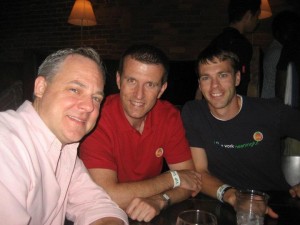Don’t just choose the better candidate, choose the candidate that makes your company better.
Next time you’re trying to choose between two similar candidates, consider which one makes your organization more valuable.
Don’t just choose the better candidate, choose the candidate that makes your company better.
Next time you’re trying to choose between two similar candidates, consider which one makes your organization more valuable.
Have you ever wondered how to read a resume to get the best understanding of the candidate’s fit for the job? What’s the most important part to focus on?
Is it the objective? Is it where you went to school? Maybe it’s your last employer?
It’s not any of those things. Well, not according to Todd Carlisle, Director of Staffing at Google. He believes the most important part of the resume is the bottom portion, where people normally list things like hobbies, activities, volunteer experience, etc.
Candidates\’ early work experience, hobbies, extracurricular activities or nonprofit involvement—such as painting houses to pay for college or touring with a punk rock band through Europe—often provide insight into how well an applicant would fit into the company culture.†source
I think that’s a great idea, and I’d have to agree that it could be valuable for ascertaining a person’s culture fit. Many professionals drop those kinds of information from their resume in order to fit in the valuable experience gleaned at other positions, so you could be missing plenty of them with a great history of volunteering and social activities if you’re only scanning resumes.
That’s where the next point comes in…
In the video below Jerome Ternynck, CEO of SmartRecruiters, brings an even more radical approach to the one above: get rid of resumes and use “profiles” instead. I like the idea, but I don’t know how feasible it is. Frankly, it’s easier for any company to sort through ten resumes than it is to sort through ten profiles for candidates.
And despite there being hundreds of great career resources on the web, some job seekers still have ugly resumes, poor interviewing skills, and no real career plan. Then again, that does weed the technically ignorant folks from the hiring pool (at least until they catch on). Check out the video below for more ideas on how we can get rid of resumes once and for all.
 One of the interesting things I saw at the SHRM 2012 annual conference a few weeks back was the multitude of HR professionals visiting the SHRM Hive for social media help and advice. I don’t know that there was a final count, but dozens of HR pros set up Twitter accounts during the event. However, when I tell some people about that, they just give me a blank stare.
One of the interesting things I saw at the SHRM 2012 annual conference a few weeks back was the multitude of HR professionals visiting the SHRM Hive for social media help and advice. I don’t know that there was a final count, but dozens of HR pros set up Twitter accounts during the event. However, when I tell some people about that, they just give me a blank stare.
There are several uses for Twitter for the average in-the-trenches HR professional. Here they are in no particular order:
The best part about this stuff is that you are not the first one to wonder “Is this really for me?” Hundreds of others have already asked that question, taken the leap, and never looked back. Want some help on getting set up with Twitter or another social media tool? Feel free to send me an email and I’d be happy to help.
I heard a new term to describe poor job feedback recently at the SHRM 2012 Conference, and I just had to share it here.
gunnysack feedback  [guhn-ee-sak feed-bak] noun
the act of saving all of an employee’s feedback over time and delivering it all at one time during an annual performance review; see also terrible management practices and how to increase employee turnover
 This is a really bad idea for several reasons.
This is a really bad idea for several reasons.
In short, it violates the biggest rule with regard to comments for performance reviews: treat the other person like you want to be treated. Stuck and not sure how to proceed? Here’s a crazy idea–ask them what they want! Let’s add gunnysack job feedback to the list of failed management ideas (like using Twitter for reviews).
Anyone witnessed a manager clinging to the belief that this type of performance management is a good one?

Loved having a quiet dinner with friends to unwind at SHRM. From left: John Nykolaiszyn, Jason Lauritsen, and me
I started to put “bloggers” in the title, but there are so many people from the conference who started using Twitter, Facebook, and LinkedIn for the first time, and I wanted to include those as well. These are my thoughts on where we’ve come, where we’re going, and what everyone needs to do now. Hope you’re inspired!
The SHRM 2012 annual conference is now in the books. As usual, this event consists of few days of frenzied running to sessions, meeting with old friends, making new ones, and generally having an amazing time.
I attend these events on two levels: first and foremost, I’m attending as an HR practitioner. I’m looking for ways I can help our operations team and company be better through smarter people practices. In that role I’m attending sessions, taking notes, and trying to meet people who might have insights in our industry.
On another level, I’m attending as a blogger. I’m trying to gather content, I’m trying to make connections, and I’m trying to find out what my audience is looking for in the way of great content (hint: sessions that are filled/overflowing would be good topics to explore in blog posts).
Whether you’re writing a blog, participating in the fantastic HR-related chats on Twitter, or building a Facebook community, I hope that you take the connections you’ve built to another level. I’m already talking with a few people from the conference about working on some partner projects (Heather at A Leading Solution, for instance).
Why?
Because I want to learn from them. Because I want to be energized by them. Because I want to help both of our audiences be exposed to another person who is on fire for this HR thing. And maybe, just maybe, we’ll make this profession better one person at a time.
Those of us in the blogging community aren’t any smarter than your average HR professional. We don’t even talk more than the average HR pro. We just do it louder. We channel it through the social tools to help us reach a larger audience.
When people come up to me in awe because they recognize me from my photo or blog, I just smile. I’m just a guy who likes to write and share what he’s doing right (and wrong) so people can learn a little bit. I’m no different from you, and I hope you can tell that when you’re standing there waiting for some brilliant statement to come out of my mouth, and I have nothing to say. :-)
If you looked at the Twitterstream flowing from #SHRM12, you might have seen quite a few tweets about HR professionals visiting SHRM’s Hive area for social media advice/help. SHRM (and Curtis Midkiff, especially) did a great job of pulling in those of us passionate about using social tools in HR and leveraged our strengths and knowledge to be ambassadors for those without social media experience.
We helped set up Twitter accounts, discussed LinkedIn for recruiting purposes, and talked about using HR blogs for professional development. Each person helped was a small victory. Did we reach all 13,000 attendees? No way. But if we reached even 500 people (which isn’t an outrageous number based on the traffic we had each day), then that’s a win in my book.
I had several conversations during the event about how people “like us” have been using social media extensively for the past 3+ years. At times, it seems like the topic is old and stale, because surely “everyone” knows how to use it by now. But then I run into an HR professional at a local SHRM meeting who wants to know what Twitter is or if they should have a corporate LinkedIn page, and I realize yet again that the number of HR professionals using social tools is still relatively small compared to the size of the group overall.
On Monday I start back to work. I get back into my routine. And it would be incredibly easy to just keep going like I have been going for the past year. Or I can take the time and make the effort to keep up with the connections I made at SHRM. I can keep the promise I made to keep educating HR professionals and recruiters on the value of social tools. I can work to incorporate the things I learned at the event into what I do at work.
Only time will tell which direction I take, but what I do matters much less than what you do. Well, what’s it going to be? I’m waiting…
 On Monday at SHRM 2012 I was able to attend 5 Keys to Corporate Recruiting Leadership led by John Vlastelica. I’ve been recruiting in this job for nearly a year and a half now, and I really enjoy the hands on part of it; however, I haven’t put much thought into the overall strategy involved. As an HR Generalist, when I hear the siren song of recruiting start up, I usually am working to get it finished as soon as possible and then move onto other “important HR tasks.”
On Monday at SHRM 2012 I was able to attend 5 Keys to Corporate Recruiting Leadership led by John Vlastelica. I’ve been recruiting in this job for nearly a year and a half now, and I really enjoy the hands on part of it; however, I haven’t put much thought into the overall strategy involved. As an HR Generalist, when I hear the siren song of recruiting start up, I usually am working to get it finished as soon as possible and then move onto other “important HR tasks.”
In other words, I sorely needed this session.Â
Here are a few of my big takeaways from John’s presentation.
There are three levels to focus on-the organizational level, the departmental level, and the requisition level. It’s easy to get sucked into each position and not consider the big picture. How does this position fit into the mission and goals for the organization? What about for the department/workgroup? What does the ideal candidate look like?
It’s not just an open job requisition.
When you hire someone, you’re not adding them to the team. You’re creating an entirely new team with different dynamics and social norms. Remember that every person you hire is going to change the existing team (some positions more than others); don’t ever lose sight of the importance of a single position.
John shared a story about a workgroup who was using twelve people to interview engineering candidates. Instead of approaching it as a problem to be solved (“Hey, dummy, stop wasting resources!”), he tried to listen and learn the rationale for the practice. It turned out that higher than average turnover in the department was being mitigated by allowing more of the incumbent workforce to meet and select the person they felt was the best fit for the job.
The reduced turnover more than offset the cost of additional resources allocated to the interviewing process, so what originally seemed like a problem was actually a very smart hiring practice.
There is more great content that I gathered from this session, but this is all I was able to process so far! Look for a sequel coming soon with even more information and ideas on how to rock your recruiting function. Anyone else ever get stuck in a rut and need a kick in the pants to start focusing on what matters in recruiting?
Yesterday, Jose Berrios of SHRM spent some time talking about diversity, and he mentioned using a Twitter-like tool to let managers give employee feedback in short, 140-character snippets. Many of the audience members agreed that it was a good idea, but I was quick to point out that it isn’t really that easy. My alternative solution:
Ooh! I have an idea for how to make employee performance reviews better-let's get managers to talk to employees. Novel idea. #shrm12
— Ben Eubanks (@beneubanks) June 25, 2012
In response to my comment, someone else came back with a (poor) excuse for why my idea wouldn’t work:
@beneubanks @mattmonge In my experience managers nearly always are too busy to talk / have quality conversations with their subordinates
— GCsapiens (@GCsapiens) June 25, 2012
I can’t help but laugh. HR pros need to be forcing managers to manage well, not giving them a free pass to be poor communicators. If they are not talking with their employees, that’s not going to change by offering to let them talk to their employees with a software program in snippets too small to give real, useful feedback.
Let’s fix the problem with managers who don’t take the time to talk with their people. Then we can discuss software tools that help to supplement the feedback process with more frequent, informal pieces here and there. It’s not an either/or answer–both can (and should) be used effectively.